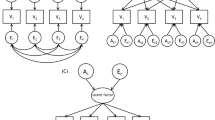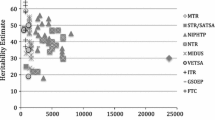Abstract
Depression symptomatology was assessed up to four times at 2-year intervals on a sample of 2100 Danish twins initially aged 70 years and older. Data were analyzed using the biometric growth model approach proposed by Neale and McArdle (2000). Results show that occasion-specific depression is moderately and equally heritable in men and women (occasion-specific estimates of heritability ranged from 22% to 37%). Estimates of phenotypic variance, genetic variance, and heritability did not vary systematically across waves. In the best-fitting growth model, depression symptomatology was accounted for by two factors: (1) a level (i.e., average) effect that was highly heritable (estimate of 69% in women and 64% in men) and reflected overall vulnerability, and (2) a residual effect that was nonheritable and reflected occasion-specific circumstances that could either exacerbate or moderate inherited vulnerability. Attempts to identify specific genetic contributions to depression might profitably focus on average levels across multiple assessments, while attempts to identify specific environmental effects might profitably focus on deviations about this average.
Similar content being viewed by others
References
Akaike, H. (1987). Factor analysis and AIC. Psychometrica 52:317-332.
Bassuk, S. S., Berkman, L. F., and Wypij, D. (1998). Depressive symptomatology and incident cognitive decline in an elderly community sample. Arch. Gen. Psychiatry 55:1073-1081.
Beekman, A. T., Copeland, J. R., and Prince, M. J. (1999). Review of community prevalence of depression in later life. Br. J. Psychiatry 174:307-311.
Bertelsen, A., Harvald, B., and Hauge, M. (1977). A Danish twin study of manic-depressive disorders. Br. J. Psychiatry 130:330-351.
Bierut, L. J., Heath, A. C., Bucholz, K. K., Dinwiddie, S. H., Madden, P. A. F., Statham, D. J., Dunne, M. P., and Martin, N. G. (1999). Major depressive disorder in a community-based twin sample: Are there different genetic and environmental contributions for men and women? Arch. Gen. Psychiatry 56:557-563.
Blazer, D. (1989). Depression in late life: An update. In M. P. Lawton (ed.), Annual review of Gerontology and Geriatrics (pp. 197-215). New York: Springer.
Blazer, D., Hughes, D. C., and George, L. K. (1987). The epi-demiology of depression in an elderly community population. Gerontologist 27:281-287.
Carmelli, D., Swan, G. E., Kelly-Hayes, M., Wolf, P. A., Reed, T., and Miller, B. (2000). Longitudinal changes in the contribution of genetic and environmental influences to symptoms of depression in older male twins. Psychol. Aging 15:505-510.
Christensen, K., Holm, N. V., McGue, M., Corder, L., and Vaupel, J. W. (1999). A Danish population-based twin study on general health in the elderly. J. of Aging Health 11:49-64.
Foley, D. L., Neale, M. C., and Kendler, K. S. (1998). Reliability of a lifetime history of major depression: Implications for heri-tability and co-morbidity. Psychol. Med. 28:957-870.
Ganzini, L., Smith, D. M., Fenn, D. S., and Lee, M. A. (1997). De-pression and mortality in medically ill older adults. J. Am. Geriatr. Soc. 45:307-312.
Gatz, M., Pedersen, N. L., Plomin, R., Nesselroade, J. R., and McClearn, G. E. (1992). Importance of shared genes and shared environments for symptoms of depression in older adults. J. Ab-norm. Psychol. 101:701-708.
Hauge, M. (1981). The Danish Twin Register. In S. A. Mednick, A. E. Baert, and B. Bachmann (eds.), Prospective longitudinal research (pp. 217-222). Oxford: Oxford Medical Publications.
Holm, N. V. (1983). The use of twin studies to investigate causes of diseases with complex etiology, with focus on cancer. Odense University, Odense, Denmark.
Jardine, R., Martin, N. G., and Henderson, A. S. (1984). Genetic co-variation between neuroticism and symptoms of anxiety and depression. Genet. Epidemiol. 1:89-107.
Johnson, W., McGue, M., Gaist, D., Vaupel, J. W., and Christensen, K. (2002). Frequency and heritability of depression symptomatology in the second half of life: Evidence from Danish twins over 45. Psychol. Med. 32:1175-1185.
Kendler, K. S., Gardner, C. O., Neale, M. C., and Prescott, C. A. (2001). Genetic risk factors for major depression in men and women; Similar or different heritabilities and same or partly dis-tinct genes? Psychol. Med. 31:605-616.
Kendler, K. S., and Prescott, C. A. (1999). A population-based twin study of lifetime major depression in men and women. Arch. Gen. Psychiatry 56:39-44.
Kendler, K. S., Walters, K. R., Heath, A. C., Neale, M. C., Martin, N. G., and Eaves, L. J. (1994). Sources of individual differences in depressive symptoms: Analysis of two samples of twins and their families. Am. J. Psychiatry 151:1605-1614.
Kennedy, G. J., Kelman, H. R., and Thomas, C. (1991). Persistence and remission of depressive symptoms in late life. Am. J. Psy-chiatry 148:174-178.
Kjøller, M. (1996). Health and morbidity in Denmark, 1994. Copen-hagen: Danish Institute for Clinical Epidemiology.
Little, R. T. A., and Rubin, D. B. (1987). Statistical analysis with missing data. New York: Wiley.
McGue, M., and Christensen, K. (1997). Genetic and environmental con-tributions to depression symptomatology: Evidence from Danish twins 75 years of age and older. J. Abnorm. Psychol. 106:439-448.
McGuffin, P., Katz, R., Watkins, S., and Rutherford, J. (1996). A hospital-based twin register of the heritability of DSM-IV unipo-lar depression. Arch. Gen. Psychiatry 53:129-136.
Neale, M. C., Boker, S. M., Xie, G., and Maes, H. H. (1999). Mx: Statistical modeling (5th ed.). Box 126 MCV, Richmond VA 23298: Department of Psychiatry.
Neale, M. C., and Cardon, L. R. (1992). Methodology for genetic studies of twins and families. Dordrecht, Netherlands: Kluwer Academic.
Neale, M. C., and McArdle, J. J. (2000). Structured latent growth curves for twin data. Twin Res. 3:165-177.
Newman, J. P. (1989). Aging and depression. Psychol. Aging 4:150-165.
Oldehinkel, A. J., Boubuys, A. L., Brilman, E. I., and Ormel, J. (2001). Functional disability and neuroticism as predictors of late-life depression. Am. J. Geriatr. Psychiatry 9:241-248.
Ormel, J., Kempen, G. I. J. M., Deeg, D. J., Brilman, E. I., van Son-deren, E., and Relyveld, J. (1998). Functioning, well-being, and health perception in late middle-aged and older people: Com-paring effects of depressive symptoms and chronic medical conditions. J. Am. Geriatr. Soc. 46:39-48.
Pálsson, S. P., östling, S., and Skoog, I. (2001). The incidence of first-onset depression in a population followed from the age of 70 to 85. Psychol. Med. 31:1159-1168.
Platz, M. (1989). The elderly in their homes. Vol. 1, Living condi-tions. Copenhagen: Danish National Institute of Social Research.
Platz, M. (1990). The elderly in their homes. Vol. 2, How do they cope? Copenhagen: Danish National Institute of Social Research.
Plomin, R., DeFries, J. C., McClear, G. E., and McGuffin, P. (2001). Behavioral genetics (4th ed.). New York: Freeman.
Prince, M. J., Beekman, A. T., Deeg, D. J., Fuhrer, R., Kivela, S. L., Lawlor, B. A., Lobo, A., Magnusson, H., Meller, I., van Oyen, H., Reischies, F., Roelands, M., Skoog, I., Turrina, C., and Copeland, J. R. (1999). Depression symptoms in late life assessed using the EURO-D scale: Effect of age, gender and marital sta-tus in 14 European centres. Br. J. Psychiatry 174:339-345.
Roberts, R. E., Kaplan, G. A., Shema, S. J., and Strawbridge, W. J. (1997). Does growing old increase risk for depression? Am. J. Psychiatry 154:1384-1390.
Roth, M., Tym, E., Mountjoy, C. Q., Huppert, F. A., Hendrie, F. A., Verma, S., and Goodard, R. (1986). CAMDEX: A standardised instrument for the diagnosis of mental disorder in the elderly with special reference to the early detection of dementia. Br. J. Psychiatry 149:698-709.
Schoevers, R. A., Geerlings, M. I., Beekman, A. T. F., Penninx, B. W. J. H., Deeg, D. J. H., Jonker, C., and van Tilburg, W. (2000). Association of depression and gender with mortality in old age. Br. J. Psychiatry 177:336-342.
Schulz, R., Martire, L. M., Beach, S. R., and Scheier, M. F. (2000). Depression and mortality in the elderly. Curr. Dir. Psychol. Sci. 9:204-208.
Rights and permissions
About this article
Cite this article
McGue, M., Christensen, K. The Heritability of Depression Symptoms in Elderly Danish Twins: Occasion-Specific Versus General Effects. Behav Genet 33, 83–93 (2003). https://doi.org/10.1023/A:1022545600034
Issue Date:
DOI: https://doi.org/10.1023/A:1022545600034




